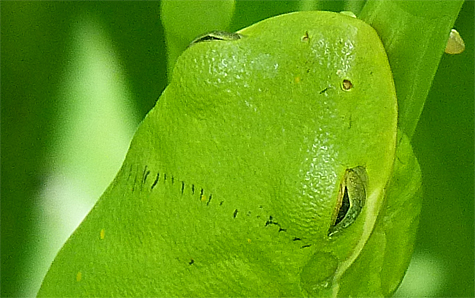I see tree frogs nearly every day in and around the Museum’s Wetlands. It’s difficult to not take photos of them, they’re so attractive. After photographing one such tree frog, a green tree frog, I noticed a line of small marks on its nape, just behind the head. The marks looked like a series of small tears in the frog’s skin.


What could have caused these tiny cuts or tears in the frog’s skin? I don’t know for sure, but I can take a guess at it. I think the frog had a very close encounter with either a bullfrog or a water snake. Both of those creatures have small teeth used for holding onto prey once captured. By the way, the snake has teeth top and bottom while the frog has a row of teeth on the top only (maxillary teeth).
Both the bullfrog and snake typically get a very good grip on whatever it is they manage to catch, it’s a death grip and they don’t let go easily. But, they don’t always hit their mark and I’ve seen both miss their targets entirely. As I said though, once captured they don’t let go, so this little tree frog was very fortunate indeed if it did have an encounter with either of those predators. But how did the tree frog break loose?
Snakes generally try to reposition whatever it is they’ve captured so that it’s a head-first entry into the digestive tract. Fins, arms, and legs can get tangled, or at the very least, cause resistance on the way down if the prey is swallowed tail or feet first. Sharp, rigid fins of a fish can do considerable damage to the inside of a snake. The tree frog could have slipped away during the repositioning process.
Frogs don’t seem to reposition their prey before swallowing. Whatever is latched onto with the frog’s sticky tongue simply goes in the mouth in whatever way it happens to be facing when it was caught. If it doesn’t all fit, the frog uses its arms to stuff the rest of it into the mouth. Once the prey is in the mouth, all that’s left to do is swallow. Gulp!
So, how would the tree frog have escaped the bullfrog? I may be going out on a long, thin limb here, but try this out. The tree frog in the photo is on a smartweed stalk. If you’ve read this Journal in the past you may have seen a posting about smartweed and the undesirable aspect of its foliage and stems. The plant gets its name from the effect it has on one’s mouth if eaten, it will make your mouth smart (hurt). It’s spicy hot, although some varieties more so than others. As I’ve said in the past, “even the red swamp crayfish won’t eat this stuff.”
I most often see tree frogs on the leaves and stems of the smartweed just off the boardwalk near the entrance to the Black Bear Enclosure, the photo above was shot there. Do you see where I’m going with this?
The tree frog had just finished mating in the water at, say, dawn. It climbed up on a stalk of smartweed to rest the day away. Along comes a damselfly, right in front of the tree frog’s face. The frog reacts and jumps at the damselfly, expertly catching it and landing on an adjacent smartweed.
The bullfrog, who had been sitting in the water, itself waiting for a snack to come swimming, flying, or jumping by, caught the action of the tree frog and immediately launched both its tongue and itself with mouth gaping at its little green cousin deftly catching it, along with a bit of smartweed.
It’s a known fact that bullfrogs posses taste buds. Smartweed tastes bad, hot, spicy. The bullfrog spits out the smartweed, “Ptooie,” and the tree frog with it. The tree frog quickly swims for cover and again climbs a stalk of smartweed to rest, and this time, lick its wounds. Hours later, I come along, see the tree frog, take its photo, and wonder why it has little black marks across its back.